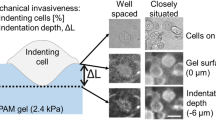Abstract
There are numerous ways to study actin cytoskeletal structures, and thereby identify the underlying mechanisms of organization and their regulating proteins. Traditional approaches make use of protein overexpression or siRNA. However to study or modulate resident endogenous proteins, complementary methods are required. Since the discovery of nanobodies in 1993, they have proven to represent interesting tools in a variety of applications due to their high affinity, solubility, and stability. Especially their intracellular functionality makes them ideally suited for the study of actin cytoskeletal regulation.
Here we provide a protocol to clone nanobody cDNAs in frame with an EGFP or mCherry fluorescent tag. We explain how to transfect this fusion protein in eukaryotic (cancer) cells and how to perform immunofluorescence. This allows microscopic analysis of endogenous (cytoskeletal) proteins and gives insight into their endogenous localization. Moreover, we outline an extracellular matrix (ECM) degradation assay as an application of the general protocol. By seeding cells onto a fluorescently labeled gelatin matrix, degradation can be quantified by means of a matrix degradation index. This assay demonstrates the contribution of a protein during cancer cell invasiveness in vitro and the potential of a nanobody to inhibit this degradation through modulation of its target.
Access this chapter
Tax calculation will be finalised at checkout
Purchases are for personal use only
Similar content being viewed by others
References
Yamaguchi H, Condeelis J (2007) Regulation of the actin cytoskeleton in cancer cell migration and invasion. Biochim Biophys Acta 1773(5):642–652. doi:10.1016/j.bbamcr.2006.07.001
Chhabra ES, Higgs HN (2007) The many faces of actin: matching assembly factors with cellular structures. Nat Cell Biol 9(10):1110–1121. doi:10.1038/ncb1007-1110
Ridley AJ (2011) Life at the leading edge. Cell 145(7):1012–1022. doi:10.1016/j.cell.2011.06.010
Winder SJ, Ayscough KR (2005) Actin-binding proteins. J Cell Sci 118(Pt 4):651–654. doi:10.1242/jcs.01670
Gross SR (2013) Actin binding proteins: their ups and downs in metastatic life. Cell Adh Migr 7(2):199–213. doi:10.4161/cam.23176
Yamaguchi H (2012) Pathological roles of invadopodia in cancer invasion and metastasis. Eur J Cell Biol 91(11-12):902–907. doi:10.1016/j.ejcb.2012.04.005
Linder S (2007) The matrix corroded: podosomes and invadopodia in extracellular matrix degradation. Trends Cell Biol 17(3):107–117. doi:10.1016/j.tcb.2007.01.002
Shimomura O, Johnson FH, Saiga Y (1962) Extraction, purification and properties of aequorin, a bioluminescent protein from the luminous hydromedusan, Aequorea. J Cell Comp Physiol 59:223–239
Zhang G, Gurtu V, Kain SR (1996) An enhanced green fluorescent protein allows sensitive detection of gene transfer in mammalian cells. Biochem Biophys Res Commun 227(3):707–711. doi:10.1006/bbrc.1996.1573
Hamers-Casterman C, Atarhouch T, Muyldermans S, Robinson G, Hamers C, Songa EB, Bendahman N, Hamers R (1993) Naturally occurring antibodies devoid of light chains. Nature 363(6428):446–448. doi:10.1038/363446a0
Muyldermans S (2013) Nanobodies: natural single-domain antibodies. Annu Rev Biochem 82:775–797. doi:10.1146/annurev-biochem-063011-092449
Hassanzadeh-Ghassabeh G, Devoogdt N, De Pauw P, Vincke C, Muyldermans S (2013) Nanobodies and their potential applications. Nanomedicine 8(6):1013–1026. doi:10.2217/nnm.13.86
Delanote V, Vanloo B, Catillon M, Friederich E, Vandekerckhove J, Gettemans J (2010) An alpaca single-domain antibody blocks filopodia formation by obstructing L-plastin-mediated F-actin bundling. FASEB J 24(1):105–118. doi:10.1096/fj.09-134304
De Clercq S, Boucherie C, Vandekerckhove J, Gettemans J, Guillabert A (2013) L-plastin nanobodies perturb matrix degradation, podosome formation, stability and lifetime in THP-1 macrophages. PLoS One 8(11):e78108. doi:10.1371/journal.pone.0078108
De Clercq S, Zwaenepoel O, Martens E, Vandekerckhove J, Guillabert A, Gettemans J (2013) Nanobody-induced perturbation of LFA-1/L-plastin phosphorylation impairs MTOC docking, immune synapse formation and T cell activation. Cell Mol Life Sci 70(5):909–922. doi:10.1007/s00018-012-1169-0
Van Audenhove I, Boucherie C, Pieters L, Zwaenepoel O, Vanloo B, Martens E, Verbrugge C, Hassanzadeh-Ghassabeh G, Vandekerckhove J, Cornelissen M, De Ganck A, Gettemans J (2014) Stratifying fascin and cortactin function in invadopodium formation using inhibitory nanobodies and targeted subcellular delocalization. FASEB J 28(4):1805–1818. doi:10.1096/fj.13-242537
Van Impe K, Bethuyne J, Cool S, Impens F, Ruano-Gallego D, De Wever O, Vanloo B, Van Troys M, Lambein K, Boucherie C, Martens E, Zwaenepoel O, Hassanzadeh-Ghassabeh G, Vandekerckhove J, Gevaert K, Fernandez LA, Sanders NN, Gettemans J (2013) A nanobody targeting the F-actin cap** protein CapG restrains breast cancer metastasis. Breast Cancer Res 15(6):R116. doi:10.1186/bcr3585
Van Overbeke W, Verhelle A, Everaert I, Zwaenepoel O, Vandekerckhove J, Cuvelier C, Derave W, Gettemans J (2014) Chaperone nanobodies protect gelsolin against MT1-MMP degradation and alleviate amyloid burden in the gelsolin amyloidosis mouse model. Mol Ther 22:1768. doi:10.1038/mt.2014.132
Van Audenhove I, Van Impe K, Ruano-Gallego D, De Clercq S, De Muynck K, Vanloo B, Verstraete H, Fernandez LA, Gettemans J (2013) Map** cytoskeletal protein function in cells by means of nanobodies. Cytoskeleton 70:604. doi:10.1002/cm.21122
Ghassabeh GH, Saerens D, Muyldermans S (2010) Isolation of antigen-specific nanobodies. In: Kontermann R, Dübel S (eds) Antibody engineering, vol 2. Springer, Berlin. doi:10.1007/978-3-642-01147-4_20
Author information
Authors and Affiliations
Corresponding author
Editor information
Editors and Affiliations
Rights and permissions
Copyright information
© 2016 Springer Science+Business Media New York
About this protocol
Cite this protocol
Van Audenhove, I., Gettemans, J. (2016). Use of Nanobodies to Localize Endogenous Cytoskeletal Proteins and to Determine Their Contribution to Cancer Cell Invasion by Using an ECM Degradation Assay. In: Gavin, R. (eds) Cytoskeleton Methods and Protocols. Methods in Molecular Biology, vol 1365. Humana Press, New York, NY. https://doi.org/10.1007/978-1-4939-3124-8_12
Download citation
DOI: https://doi.org/10.1007/978-1-4939-3124-8_12
Publisher Name: Humana Press, New York, NY
Print ISBN: 978-1-4939-3123-1
Online ISBN: 978-1-4939-3124-8
eBook Packages: Springer Protocols




